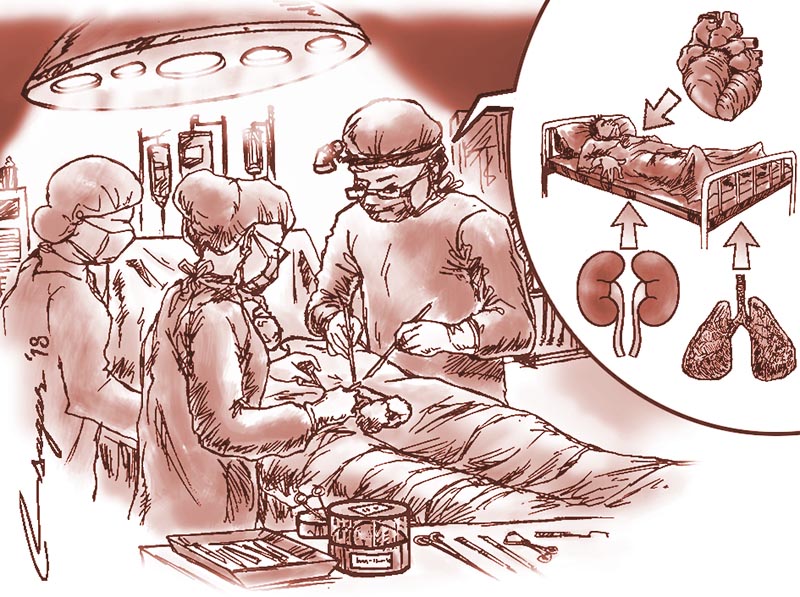Organ transplant: Let’s talk about it
There are some government hospitals providing this service free of cost to the Nepalese citizens. Shahid Dharmabhakta National Transplant Centre at Bhaktapur is a centre solely dedicated to enhancing organ transplantation in the country
End stage organ failure can happen to a number of important solid organs, such as the kidney, liver, heart, lung, pancreas and intestine. Worldwide, organ transplantation is the current standard of treatment of these conditions where donors are available as it offers a better quality of life than other alternatives of treatment. Organ transplantation can be done from a living as well as a cadaveric/ brain-dead donor.
Kidney transplantation services have shown enormous success in Nepal. There are some government hospitals providing this service free of cost to the Nepalese citizens. Shahid Dharmabhakta National Transplant Centre (SDNTC) at Bhaktapur is a centre solely dedicated to enhancing organ transplantation in the country. It has conducted 542 kidney transplants within six years of its establishment. Though the service is yet to be expanded in other parts of Nepal, the need for people to travel to neighbouring countries for transplantation has been minimised.
It is estimated that there are 3,000 cases of renal and 1,000 cases of liver failures every year in Nepal. No figures are available for the failure of other organs, such as the heart, lung and pancreas. Considering there are 3 million diabetic patients in Nepal, the incidence of these will not be far behind world statistics.
Organs can be donated by related or non-related living donors, whose tissues match. Studies show that compared to cadaveric donor kidneys, live donor kidney transplants experience a higher success rate as well as a longer life span of the transplanted organ. In the case of a non-living donor, the full health history of the deceased may not be available, such as drug use, alcoholism or other factors that may affect the quality of the kidney. In the case of a living donor, the organ is transplanted immediately into the recipient in an operating room, so the organ is only without blood supply for a short period of time. Living donor organ usually functions immediately, making it easier to monitor.
Organs can be donated from cadaveric donors who have sustained brain death (due to severe injury in the brain). Cadaveric donations allow usage of multiple organs, which would otherwise have been wasted. One cadaveric donor can supply two kidneys, two lungs, one liver, one heart, one pancreas and one intestine, a total of eight solid organs to save eight lives.
In Nepal, the process of cadaveric organ donation is regulated by the Human Organ
Transplantation Regulation 2073. Accordingly, the first step to a cadaveric organ donation is to declare that the patient has sustained brain death. Shahid Dharmabhakta National Transplant Centre (SDNTC), Bhaktapur has been designated as the coordination unit for cadaveric organ donation and transplantation. Once the centre is informed, coordinators and a transplant team visit the donor hospital to assess the donor. If the donor is suitable, the transplant team assists in donor management and subsequently transfers the patient to the operating theatre for organ harvesting.
Nepal too has performed four kidney transplantations from two brain-dead donors at the Shahid Dharmabhakta National Transplant Centre, Bhaktapur. The first such transplantation was conducted on May 11, 2017. A pair of kidneys from a 31-year-old road traffic accident victim undergoing treatment at Kantipur Hospital was donated by his relatives. A 15-year-old boy and a 25-year-old male underwent kidney transplant surgery successfully.
More than a year of the successful surgery, we got a call from the family of a 72-year-old man who had lost his life at the Shree Ganeshman Singh Memorial Hospital and Research Centre in a cerebro-vascular accident. Two kidneys were harvested from his body and transplanted in a 30-year-old and a 56- year-old man.
All four patients are doing well with good graft function. This transplant wouldn’t have been possible without the family’s support. In accordance with the law, a committee of a hospital doctor, forensic expert and police officer confirmed the brain death and allowed organ harvesting prior to the formal post mortem examination. The staff at every level from the cleaner to the consultant surgeons worked tirelessly throughout the night to finish the transplant as soon as possible and give the best result to the patients.
However, due to the lack of awareness, superstitious beliefs, various socio-cultural, religious and economic factors, the rate of cadaveric organ donation is very low in Nepal.
The four cadaveric donor kidney transplants have added a milestone to the history of medicine in Nepal. Nepal has developed capable human resources and the physical infrastructure to start the programme, but there is a long road ahead to make it available as an option to all the Nepalese.
First, there is need of a massive awareness programme across the country regarding the importance of cadaveric organ donation and transplantation, and, secondly, there are limited transplant facilities in the country.
Thus, this programme needs support from all sections of society and government to halt the gap between supply and demand of organs in Nepal.
Dr Shrestha is Executive Director and Chief Transplant Surgeon at the Shahid Dharmabhakta National Transplant Centre, Bhaktapur






